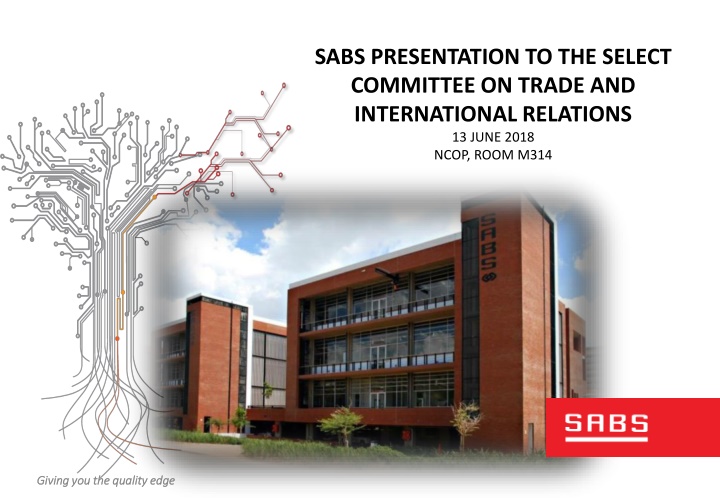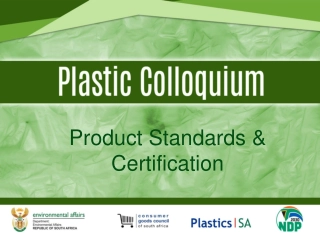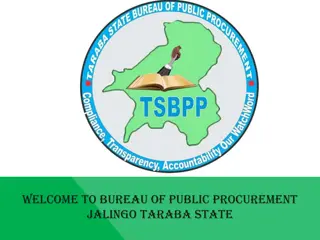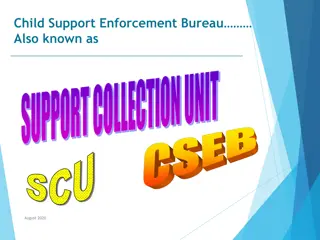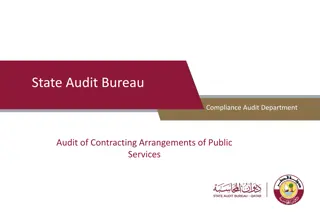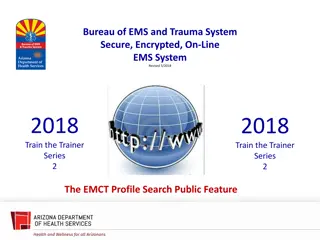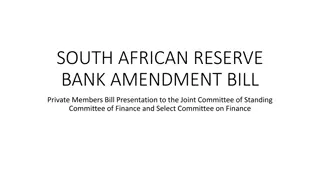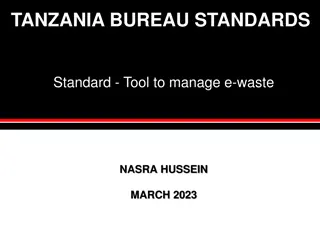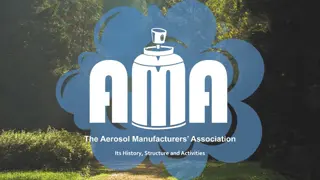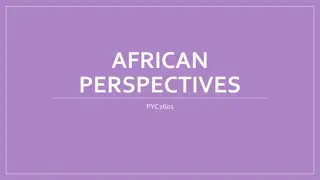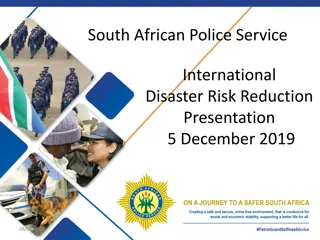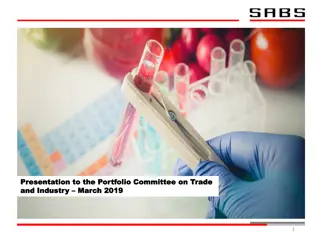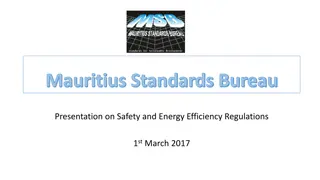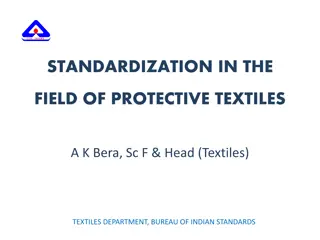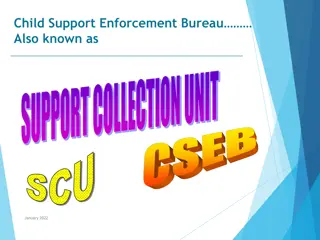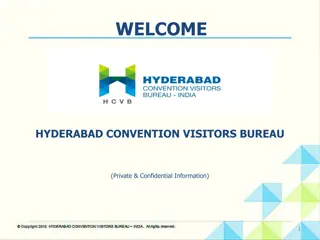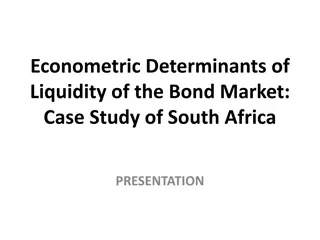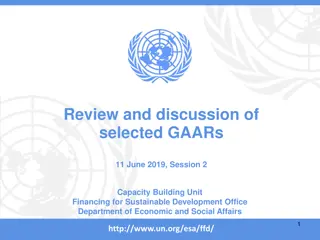Overview of South African Bureau of Standards (SABS)
The South African Bureau of Standards (SABS) is the national standardization institution in South Africa, established by the Standards Acts of 1945 and 2008. SABS aims to develop, promote, and maintain South African National Standards (SANS), provide conformity assessment services, and uphold values like impartiality, innovation, and quality. Its statutory mandate includes grant-funded projects and services for various sectors. SABS plays a crucial role in enabling access to standards, ensuring fair competition, and supporting inclusive growth in South Africa.
Download Presentation

Please find below an Image/Link to download the presentation.
The content on the website is provided AS IS for your information and personal use only. It may not be sold, licensed, or shared on other websites without obtaining consent from the author.If you encounter any issues during the download, it is possible that the publisher has removed the file from their server.
You are allowed to download the files provided on this website for personal or commercial use, subject to the condition that they are used lawfully. All files are the property of their respective owners.
The content on the website is provided AS IS for your information and personal use only. It may not be sold, licensed, or shared on other websites without obtaining consent from the author.
E N D
Presentation Transcript
SABS PRESENTATION TO THE SELECT COMMITTEE ON TRADE AND INTERNATIONAL RELATIONS 13 JUNE 2018 NCOP, ROOM M314 Giving you the quality edge Giving you the quality edge
Overview of the SABS 1 1. SABS is the peak national standardisation institution in South Africa, established by the Standards Act, 1945 (Act 24 of 1945), and continues to exist as a commercialised public entity under the Standards Act, 2008 (Act 8 of 2008). The objectives of SABS are as follows: Develop, promote and maintain South African National Standards (SANS) Promote quality in connection to commodities, products and services Render conformity assessment services and matters connected therewith 2. Vision To be the trusted standardisation and quality assurance service provider of choice 3. Mission The SABS provides standards and conformity assessment services to contribute towards the efficient functioning of the economy. 4. Values As the SABS transforms and moves towards a culture of high performance in delivering standardisation services, it is guided by the following values: Impartiality Innovation Accountability Integrity Quality Customer Centricity Legislative Mandate
Overview of the SABS 2 Statutory Statutory Develop, promote and maintain South African National Standards (SANS) mandate Grant funded 25% Funding sources Certification Laboratory Services Training/SMME Commercial SABS Mark Product Certification System Certification . Conducts local content verification &Conducts inspections, calibrations, proficiency schemes, and tests against standards Testing of products in line with ISO/IEC international protocols for laboratories Training on Standards Technical support to SMMES and entrepreneurs on standardisation services 75% mandate Funded from fees charged for services offered in a competitive market Accessibility Acoustics Adhesive and packaging Agrochemicals Automotive Building and construction Chemicals Chromatography Civil engineering Clothing and protective wear Electronics appliances Energy efficiency Engineering Environment (EMS) Explosion prevention Fibre and polymers Food and beverages Industrial chemistry Lighting technology Mechanical and fluids Medical and health Metrology Mining and minerals Paints and sealants Petrochemical Pharmaceutical Radiation protection Rotating machinery Rubber and plastics Safety and security Solar water heating Textiles and leather Timber Transportation Key sectors supported Growth Customer centricity Productivity Competent & empowered employees Strategic Themes
Our Value Offering to Society and Business 3 What we do Benefit to Society Benefit to Industry Benefit to South Africa - Enable access to standards and conformity assessments that facilitate trade and protection of consumers and the environment - Fair competition Development of national standards for processes, systems, services and products Fair and transparent process to set National Standards Support inclusive growth Test, inspect, verify and certify processes, products and services against requirements in the standards - Quality assurance for consumers - Fairness in the market - Protect local employment - Enable local production - Fair competition - Safety to consumers Enable producers and suppliers to compete fairly - Increase production of intellectual capital - Improve speed to market - Facilitate new entrants to the market Promote the use of standards for socio- economic development Facilitation of access to to standards and related services Provide platform for support to access services by SMMEs Provide training on standards and conformity related assessment services Ensure compliance to standards proficiency in quality management Fair trade environment where standards are consistently applied in the procurement of products and services Correct implementation and use of standards
Our National Footprint 4 The SABS head office is in Groenkloof in the City of Tshwane. The organisation has seven other satellite facilities spread across South Africa.
Our Governance Structure 5 Department of Trade and Industry Board of Directors Human resources & remuneration committee Finance & investment committee Social & ethics committee Nominations committee Audit committee Risk committee Director s Name JEFF MOLOBELA Classification Independent non-executive chairman DR MICHAEL ELLMAN Independent non-executive director WEBSTER MASVIKWA Independent non-executive director ELEKANYANI NDLOVU Independent non-executive director NIVASHNEE NARAINDATH Independent non-executive director ZANELE MONNAKGOTLA Independent non-executive director GARTH STRACHAN DR BONI MEHLOMAKULU Shareholder representative Executive Director and CEO * One Independent non-executive director resigned in January 2018
REFLECTING ON 2017/18 PERFORMANCE Giving you the quality edge Giving you the quality edge
Developing National Standards 6 1. Legislative mandate Total number of standards published SABS continue to focus on the following: Develop and maintain national standards for economic impact Ensures broader participation in the development of standards through technical committees Promotes and creates awareness about standards Maintains South African voting presence on international standardisation bodies 600 498 470 500 370 400 314 300 218 200 100 0 2014 2015 2016 2017 2018 2. Highlights for 2017/18 New standards published per sector Steady increase of home grown standards to support IPAP efforts, 314 standards published of which 147 were home-home grown 25 20 15 10 Conducted three external stakeholder consultation workshops; namely: 5 0 Agriculture Electrical engineering Mathematics Other Health care technologies Information technology Telecomunications Electronics Generalities Environment and health Civil engineering Mining and minerals Image technology Metrology and equipment Domestic and commercial Manufacturing engeneering Petroleum and related Construction materials and Energy and heat transfering Textile and leather technology Fluid systems and components Services o Energy Sector o Agro-processing Sector, and o Construction Sector. technologies protection engineering building 2016 2017 2018
Performance Key Highlights for 17/18 7 Key performance area Annual Target Q4 YTD Target Q4 YTD Actual Status Growth Revenue from services Operating profit % New products/services offered R563.3 (m) 0% 2 R563.3 (m) 0% 2 R520.5 (m) 3.00% 2 Customer Centricity SMMEs supported Number of sector publications 70 4 70 4 92 3 % of development projects completed as per IPAP >80% >80% 82% Productivity % of testing laboratories that are profitable >55% >55% 61% Implementation of the Standards Action Plan 65% 65% 75% Number of services automated 3 for 17/18 3 for 17/18 4 for 17/18 Complete Complete Appointment of partner deferred Progress on implementation of Property Plan Groenkloof property development plan Groenkloof property development plan Competent and empowered employees Number of technical employees trained Number of post graduates appointed in identified areas 8 2 8 2 13 3 Performance Results are subject to verification by external audit
THE YEAR AHEAD 2018/19 Giving you the quality edge Giving you the quality edge
SABS Strategic Objectives 8 Increase in the use of standardisation services by broadening the scope of service Growth Develop and retain a competent human resource that is aligned with the organisation s mandate Put the customer at the forefront of everything Customer Centricity Empowered Staff Strategy we do Productivity Improve the operational performance of the SABS to enable delivery of quality outputs for customers and the South African economy
Target 1: Growth 9 1. Increase in revenue from services 2. New Products & Services 657.8 700 6 601.8 560.4 557.3 544.7 600 532.5 5 500.9 5 500 400 4 4 300 200 3 100 0 2 2 2 1 Actual Budget 0 2017/18 2018/19F 2019/20F 2020/21
Target 4: Competent and empowered employees 10 20 18 18 16 14 12 12 10 10 8 8 8 6 6 6 4 2 2 2 2 0 8. Number of technical employees that have completed specialist training with leading partners 9. Number of Doctoral and Masters graduates recruited or developed to support Testing and Standards Development 2016/17 2017/18 2018/19F 2019/20F 2020/21F
SABS CONTRIBUTION TO IPAP 10 Giving you the quality edge Giving you the quality edge
Alignment to IPAP 11 Programme to development and revise 12 new Standards : Six projects in the Laboratories & Design Institute: Enhances localisation of clothing, textile, leather and footwear - safety of products Enhances market access for SMMEs - support government and industry initiatives (e.g. Jobs Fund) Supports expansion of plastics, pharmaceuticals, chemicals and cosmetics - safety of products Supports commercialisation of Indigenous solutions - traditional medicines testing Supports growth of agro-processing and ocean economy - food, fish and abalone Enables diversification sources and demand of electricity - investment to renew and modernise equipment Enables management of energy demand and efficiency - buildings, electrical cables Contributes to sustainability of water supply - reuse of grey water Helps to create regional supply chains and infrastructure - general and electrical supply
SABS INTERNAL DIGITISATION STRATEGY Giving you the quality edge Giving you the quality edge
SABS Digitisation Transformation Imperative 12 Based on recommendations from international accreditation bodies such as RvA and FSSC, the SABS has focussed its immediate digitisation implementation to its Certification business, and the following new systems have already yield improvement in the business divisions: An online system that enables customers to process their new and re-certification applications electronically, with system generated statuses of their applications A backend Approvals Board system automated and digitised the certification approvals process with major efficiency gains in approval turn-around times An online tool to effectively monitor and report SABS Mark abuse incidents by real-time globally scanning market- place websites and company websites. This was further enhanced with an automated IP infringement case tracking system The SABS Business Intelligence Centre of Excellence was successfully established and is producing invaluable business performance dashboards and reporting that has, and will enable informed decision making, e.g. the actual status of expired certificates, such as root causes, aging analysis and heat maps The Customer Dashboard solution has enabled the first deliverables towards a Consolidated View of the Customer to enable an improved customer handling experience for the customers To enable its digitisation journey, the SABS data infrastructure is being upgraded, which will increase the Pretoria and Durban sites from a single 40Mb and 3Mb respectively to two 120Mb lines at each site
SABS Digitisation Strategy and Roadmap 13 The SABS Digitisation Strategy and Implementation Plan was approved at the SABS Board meeting held in November 2017. The plan is aligned with, and shall be executed in accordance with the 2018/19 to 2020/21 SABS Corporate Plan Sustainable digital technologies and tools, such as Natural Interfaces, Internet of Things (IoT), Cognitive Systems and Next Generation Security are the primary innovation enablers within this plan The budgetary implications of the Digitisation Strategy is approximately R300 million over a three year period The SABS has adopted a holistic approach to digitising its business, which integrates its customers, people, business processes technology and key stakeholders The immediate focus areas for 2018/19 are to radically improve customer engagements in the following manner: A single view of the customer will be enabled through a new CRM tool Multi-channel customers engagements will be integrated with a comprehensive online portal for all customer engagements Customer engagement business processes will be optimised and effectively measured
SABS CONTRIBUTION TO THE 4TH INDUSTRIAL REVOLUTION Giving you the quality edge Giving you the quality edge
SABS Contribution to the 4th Industrial Revolution 14 The SABS contributes to the 4th Industrial Revolution on the following levels: First Level - Facilitate the development of standards governing the various aspects of digitisation and smart concepts such as smart cities, smart industries, etc. within its legislative mandate through: Participating in various international forums dealing with the development of standards for Industry 4.0 / The 4th Industrial Revolution and other digitisation initiatives The IPAP commitments for 2018/19, which includes the development of three separate electro-technical standards. This is over and above the ongoing standards revision work and those standards already published in the current financial year Participating in the work of the SDG 15 looking at networks, technologies and infrastructures for transport access and home, which amongst other things, is developing standards to enable the evolution towards intelligent transport networks including the support of smart-grid applications Leveraging these global participations and best practices and apply thought leadership to its effective and efficient implementation to support the NDP, IPAP and the National e-Strategy Second Level - Participate and add value in any dti coordinated or collaborative initiatives to execute on the 4th Industrial Revolution initiatives Third Level - Proactively implement the SABS digitisation plan and where possible, use learnings to inform points 1 and 2 above and provide consulting/implementation services to other dti/government/SMMEs
APPENDIX: FINANCIAL STATEMENTS Giving you the quality edge Giving you the quality edge
Statement of Financial Performance 15 Actual R'000 2014/15 Actual R'000 2015/16 Actual R'000 2016/17 Budget R'000 2017/18 YTD R'000 Dec-17 Forecast R'000 2017/18 Budget R'000 2018/19 Budget R'000 2019/20 Budget R'000 2020/21 % Growth Commercial Revenue 558 340 543 953 500 574 563 263 372 308 532 495 560 391 5% 601 757 657 590 Other Income 24 127 66 754 43 957 24 667 21 401 24 574 28 274 15% 30 026 31 988 Government Grant 193 051 189 662 183 211 243 162 183 329 243 162 234 517 -4% 247 650 261 152 Total income 775 519 800 370 727 742 831 092 577 038 800 230 823 182 3% 879 433 950 730 Administrative and operating expenses Employee benefits Contract Services Strategic projects Premises costs Marketing and communications Consulting and technical fees Consumables Travel foreign Travel local Municipal services Other operating expenses Profit/(loss) from operations Depreciation Government grants in respect of assets Profit/(loss) before other income/expenses, interest and tax Other income Other non-operating expenses Forex losses Loss on disposal of property, plant and equipment Post-retirement medical aid and pension Long service leave awards Prior year adjustments Income statement losses Royalties Performance bonus Bad debts Audit fees Other expenses Profit/ (loss) before interest, corporate charges and tax Finance income/ (costs) Profit/ (loss) before corporate charges and tax (704 317) (473 924) (62 335) (10 452) (14 365) (14 946) (22 620) (40 417) (52 112) 71 202 (47 941) 10 485 (727 404) (497 888) (69 700) (4 371) (6 730) (8 541) (15 202) (15 381) (19 410) (41 938) (48 242) 72 966 (51 336) 11 202 (727 717) (507 957) (59 753) (4 399) (5 192) (10 795) (12 930) (16 139) (17 974) (47 651) (44 927) (38 597) (824 856) (581 647) (60 192) (5 746) (4 535) (7 250) (13 998) (16 564) (16 777) (18 910) (48 939) (50 298) (50 699) (561 071) (397 136) (42 098) (3 360) (3 551) (5 825) (10 372) (11 880) (13 846) (38 798) (34 205) 15 966 (32 623) 6 692 (760 175) (538 908) (56 565) (4 465) (5 061) (8 181) (13 060) (16 968) (18 544) (51 419) (47 003) 40 055 (48 721) 8 879 (785 371) (565 149) (56 565) (4 638) (5 061) (8 181) (13 975) (16 968) (18 544) (49 180) (47 111) 37 811 (48 995) 8 601 3% 5% 0% 0% 4% 0% 0% 7% 0% 0% -4% 0% -6% 1% -3% (824 726) (595 171) (59 732) (4 898) (5 345) (8 639) (14 757) (17 918) (19 583) (48 934) (49 749) 54 708 (53 995) 9 082 (857 655) (619 475) (63 018) (5 167) (5 639) (9 114) (15 569) (18 903) (20 660) (47 625) (52 485) 93 075 (56 495) 9 582 - - - - - - - - (3 366) (9 780) 25 6 236 8 016 7 501 33 745 1 248 (24 831) (1 062) 32 832 4 191 (39 930) (1 357) (30 557) 1 086 (45 379) (6 179) (36 961) (9 965) 1 606 (46 763) (1 196) (85 380) (3 187) 214 (2 583) - (33 069) -1310% -100% 61% 100% 9 795 - (35 206) 46 163 (36 502) - 1 192 - (28 119) - - - - (208) (8 163) (864) - (15) (694) (3 431) (6 726) (3 190) (478) (289) (9 004) (426) - - (1 165) (5 114) (20 023) (3 030) 478 (281) (8 491) 987 - - (454) (20 076) (7 620) (3 264) - (23) (8 472) (3 873) (1 115) (20 122) (44 913) (3 684) (15) (17 176) (3 137) (3 550) - 100% -5% -77% 0% 0% -75% -15% -93% -4% 0% (8 478) (946) (298) (18 378) (3 357) (3 749) - (8 945) (998) (314) (18 664) (3 626) (3 955) - (9 484) (1 500) - - (900) (8 155) (5 010) (3 070) - (6 354) (2 905) (8 029) (895) - - (282) - - - - - - (445) (14 610) (18 715) (2 514) (1) - - - - - 10 163 22 530 (2 907) 25 270 (74 850) 30 462 (65 080) 12 605 (55 121) 18 363 (83 974) 18 753 (35 652) 18 956 -58% 1% (25 410) 12 018 9 661 (9 622) 32 693 22 363 (44 388) (52 475) (36 758) (65 221) (16 696) 74% (13 393) 40
Statement of Financial Performance 16 Actual Actual Actual Forecast Projected budget 2018/19 R'000 Projected budget 2019/20 R'000 Projected budget 2020/21 R'000 Mar 2015 R'000 Mar 2016 R'000 Mar 2017 R'000 2017/18 R'000 ASSETS Non-current assets 1 148 592 1 159 762 1 181 312 1 182 872 1 362 763 1 519 378 1 652 602 Fixed assets Available-for-sale investments Deferred taxation 732 367 395 898 20 327 732 191 407 244 20 327 734 165 427 338 19 809 749 971 413 092 19 809 1 027 017 315 937 19 809 1 280 081 219 488 19 809 1 437 236 195 557 19 809 339 265 303 648 240 750 270 039 278 618 282 469 300 012 Current assets Inventory Trade and other receivables Cash and cash equivalents 1 964 137 194 200 107 1 563 139 310 162 775 1 640 147 167 91 943 1 738 151 582 116 719 1 842 159 161 117 615 1 953 167 119 113 397 2 070 175 475 122 467 Total assets 1 487 857 1 463 410 1 422 062 1 452 911 1 641 381 1 801 847 1 952 614 EQUITY AND LIABILITIES Equity and reserves 962 135 940 628 875 196 836 106 835 255 832 914 844 021 Accumulated profit Capital and reserves 841 019 121 116 863 373 77 255 818 985 56 211 753 763 82 343 737 068 98 188 723 675 109 239 723 713 120 308 376 997 365 172 375 486 367 076 510 388 578 689 591 742 Non-current liabilities Employment benefit obligations Deferred income Interest bearing borrowings 102 027 274 970 101 263 263 909 101 576 273 910 102 045 265 031 103 958 256 430 150 000 106 028 247 348 225 313 108 268 237 765 245 709 - - - - 148 725 157 610 171 380 249 730 295 737 390 244 516 851 Current liabilities Trade and other payables Employment benefit obligations Interest bearing borrowings Deferred income 128 427 9 148 11 150 137 382 9 219 11 009 153 597 10 219 7 564 230 396 10 455 8 879 276 475 10 662 8 601 345 593 10 882 24 687 466 551 11 114 29 604 9 582 - - - - - 9 082 Total equity and liabilities 1 487 857 1 463 410 1 422 062 1 452 911 1 641 381 1 801 847 1 952 614
Statement of Financial Performance 17 Actual Actual Actual Forecast budget 2017/18 R'000 Projected budget 2018/19 R'000 Projected budget 2019/20 R'000 Projected budget 2020/21 R'000 Mar 2015 R'000 Mar 2016 R'000 Mar 2017 R'000 51 364 33 030 (12 458) 54 304 63 936 95 341 162 407 Cash inflow/(outflow) from operating activities Cash received from customers Cash received from government Cash paid to suppliers and employees 582 346 183 211 (736 878) 606 753 189 663 (788 760) 538 536 183 211 (764 349) 553 845 243 162 (761 456) 581 086 234 517 (770 623) 623 825 247 650 (788 152) 681 222 261 152 (770 345) Cash generated from/(utilised by) operations Net finance revenue/(cost) 28 679 22 685 7 656 25 374 (42 602) 30 144 35 551 18 753 44 980 18 956 83 323 12 018 172 029 (9 622) (137 534) (70 362) (63 953) (29 527) (213 041) (199 559) (178 650) Cash outflow from investing activities Purchase of fixed assets Purchase of investment properties Purchase of intangible assets Proceeds on disposal of property, plant and equipment Purchase of available-for-sale investments Disposal of available-for-sale investments (60 622) (5 167) (71 978) (46 480) (42 459) (273) (124 225) 103 000 (64 527) (15 000) 50 000 (326 041) (12 000) 125 000 (307 059) (7 500) 115 000 (213 650) (5 000) 40 000 - (63) - - - - - - - - - - - - - (5 697) - (298 792) 280 670 233 4 - 2 819 - 5 579 - 150 000 100 000 25 313 Cash inflow from financing activities Increase in interest bearing borrowings Funding for government specific projects - - - - - - 150 000 100 000 25 313 2 819 5 579 - - - (83 351) (37 332) (70 832) 24 777 895 (4 218) 9 070 (Decrease)/increase in cash and cash equivalents 283 458 200 107 162 775 91 943 116 720 117 615 113 397 Cash and cash equivalents at beginning of year 200 107 162 775 91 943 116 720 117 615 113 397 122 467 Cash and cash equivalents at end of year
THANK YOU SIYABONGA Giving you the quality edge Giving you the quality edge
